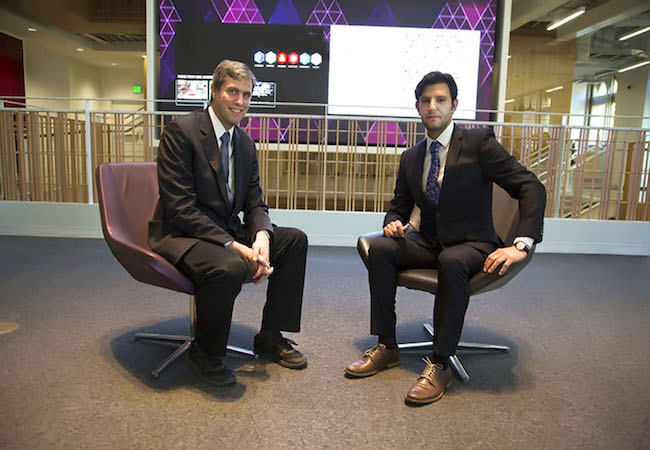Dr. Aaron Hagedorn, worldwide admired leader in the field of gerontology

By Alexander Woodman
Gerontology is the comprehensive study of aging and the issues associated with the physical, social, and mental changes of the population. This could further include such areas as elder abuse, as well as working with their caregivers, nurses, mental health and occupational therapists. Gerontology, a science which combines such disciplines as biology, physiology, psychology, and sociology, has emerged as a primary focus since our older population is living longer. Worldwide gerontologists are focused on preserving and improving the quality of life of this population which has increased due to the investigation, progress, encouragement and direct contact with the aging community.
The USC Leonard Davis School is at the heart of aging research, with programs that have guided many to explore and advance the field of Gerontology. The mission of the USC Leonard Davis School of Gerontology is to “promote healthy aging for diverse individuals, communities and societies through leadership and innovation in research, education and practice.” No leader in the field of Gerontology has been more influential than Dr. Aaron Hagedorn; Assistant Clinical Professor at USC. His knowledge and enthusiasm in the classroom and his research has inspired both professionals in the industry and the younger generation of future practitioners. His focus has been to continue the progress in the field as well as on the organizations which provide a variety of services to the elderly. He has inspired and increased the passion in the field of Gerontology through his knowledge, his research, and the education of his students. His wide range of publications has influenced many aspects of public health, and his work is admired around the world.
Recently, I had the honor to sit-down with my life-long mentor and teacher Dr. Aaron Hagedorn and discussed global health and aging population worldwide.
AW: Nowadays, the signs of an aging population are registered everywhere. According to the forecasts of the U.N.O., the number of elderly residents in the world is a staggering number. This refers to those individuals who are aged 65 years old and over, who will make up 25.2% of the population by 2050. Those aged 85 years-old, will comprise about 5% of the population. When compared to the same year in the 20th century, 1950, the proportion of the population aged 65 and older (15.6%), the number will more than be double that of children under the age of five (7.2%). The question then becomes; what are the main reasons for this geometrical progression of the aging world?
AH:The real reason populations are aging is not because of large gains in life expectancy but rather declines in fertility. As people have fewer children older people make up a larger proportion of the population. People are not living exceptionally longer yet; total life span has not changed, life expectancy rises very slowly, and the odds of reaching age 100 are very low; only 1.73 per 10,000 today. You may find predictions that suggest 20 to 30% of the children today will live to age 100; but they assume diet and lifestyle will improve, but I think that is a poor assumption as sugar is in more foods than ever and each generation has a higher BMI on average at the same age than the one before. The truth is very few people live to 100 today, and baring any medical miracle discoveries, it will likely remain a rare accomplishment for the foreseeable future.
AW: Globally speaking, East Asia is one of the oldest sub-regions. This would include the oldest major country in the world; Japan (26.6%). The proportion of the older population in Asia is expected to reach 12.1%. By comparison, Europe has advanced in the area of demographic transition and will, therefore, remain the oldest region through 2050. Although, it becomes clear that the pace of aging will slow down drastically. What necessary steps need to be addressed to prevent the aging of a nation; and still support an increase in fertility? How should the world consider and efficiently deal with the issues of aging?
AH:Japan and Germany have interesting population pyramids, almost inverted pyramids, with huge bulges in the 40 to 70 age range and very a relatively proportion below age 40 in each country. Raising children is expensive and time consuming, and many have chosen to have few if any children. The solution is either immigration, which Germany allows or incentives for having children, which Japan will sometime support, literally paying people who have babies. It is not much actually, the highest incentive in Tokyo was 180,000 yen (about $1,684 US), but it had an impact in raising the birthrate. As the world becomes more globalized, it is likely older countries will loosen work visa standards and allow for more immigrants in the workforce.
AW: In one of your research studies, it was mentioned that in the United States the life expectancy in 2005 was 75.2 for males and 80.4 for females (United States National Center for Health Statistics 2008). It appears that the life expectancy in the United States has risen more slowly than that of Japan and many other countries that were once close to holding the lead in longevity rankings. The United States has now fallen behind about thirty different countries. Based upon these statistics, can we assume that just being a highly-developed country does not automatically indicate that they have a young population?
AH:There is a strong correlation between wealth and health around the world, with the longest life expectancy found in the wealthiest countries. Within countries the same association holds true and thus the reason the US is falling behind relative to our peers is health inequality. A white male at birth today can expect about 76.1 years, whereas a black male only 70.6 years. A white female can expect 80.9 years, while a black female only 74 years. As our population becomes more diverse, racial and socio-economic differences in health will impact our national statistics. We have known since the Whitehall studies, first published in 1978, that inequality is bad for health, and until the US can address inequality I expect our national health statistics to reflect the impact of inequality in social environment on health.
AW: The structure of the population of the Middle East remains young; with nearly ½ of the population below the age of 25 in 2009; which compares to only 29% in other developed countries (United Nations [UN] 2009). At the same time, many of the countries in the Middle East are firmly connected with their roots and customs. The question arises; how considerable is the chance that being connected to your origins and customs will slow down the aging process and if so, can this practice be used on the global stage to benefit millions of people?
AH:The Middle East will remain relatively young for decades. You can look at the population pyramid of each country and discover the high birth rates lead to a large proportion of young people. A high fertility rate delays population aging, but the epidemiological transition seems to happen just about everywhere, once death rates decline fertility tends to decline shortly after as we all have limited financial and food resources. There are advantages to having very close family relationships and a lifetime of social support from family that can reduce social stress and enhance quality of life.
AW: Despite the youthful population that is evident in other regions of the world, the Middle East has experienced other changes in the population and increased health-related problems. Although the issues with the most prevalent infectious diseases have been eased, they have been replaced with chronic non-communicable diseases. These now comprise 47% of the burden of disease in the region, with a prediction of an estimated rise to 60% by the year 2020. In this case, we must consider; what is the solution to this problem and how do we keep a balance between good health and longevity; and avoid non-communicable diseases?
AH:Non-communicable diseases are a sign of a success. According to the WHO, more than 86% of the deaths in France are caused by non-communicable disease. Non-communicable disease is a sign of aging, and inevitable. If your life is long enough, cardiovascular disease, cancer or Alzheimer’s is likely. The issue is not avoiding non-communicable disease, since no one lives a perfectly healthy life, but delaying them for as long as possible.
AW: Landon Jones, in his book “Great Expectations: America and the Baby Boom Generation” (1980), discussed the period known as the baby-boom generation from 1943 through 1960. During this time, annual births increased over 4,000,000 in the United States. At the same time, in many European countries, the baby-boom epidemic spread; especially in the first year following post-World War II. Why did the children of baby-boomers not adopt the experiences of their parents; since the life conditions today are much better and conducive to having more than one child?
AH:Younger generations more interested in paying more for healthier foods and stores, declining in fast food in younger US generations. More options for exercise, more research to back it up, more peer pressure with social media, greater access to gyms, schools promote effective exercise routines. We are heavily influenced by our peers and social media, not always in healthy ways, but the generations now have more tools for communication, so perhaps there may be more time effect trends rather than cohort differences going forward.
AW: In addition to many non-infectious diseases, these days the other global problem is Mental Health issues. What are the primary areas of knowledge that is needed to care for the mental health of the aging population?
AH:Science has shown many treatments could greatly alleviate mental health challenges, yet the high cost of treatment, inability to avoid stress and complexity of modern life makes treatment difficult. From a population level perspective, we need to enhance access to counseling and offer places where those facing mental health issues or loneliness can go to find social support. According to the American Psychological Association, more than half of doctor visits have a psychological basis for the issue, so upfront investment in access to mental health services could reduce the demand on other medical services.
AW: Alzheimer’s disease (AD), as well as other forms of dementia, are a growing public health concern in all parts of the world. It is predicted that by 2020, approximately 70% of the world’s population, aged 60 and above will be living in developed countries. In India, 14.2% will be in developed and modern areas. The frequency of AD in Southern India is not as low as that found in northern India. However, it is still lower than that of the average rates of AD reported in Europe and North America. Is it possible that there are specific underlying defensive factors from the AD that exist in India and are lacking in the global areas of the world?
AH:The challenge with Alzheimer’s is reliable assessment. Due to large differences in education and lifestyle, the cognitive tests used in the US in English may not work in India in another language. There are also big differences in survival rates to age 85, where the disease is most prevalent. So, I do not believe we have reliable ways to compare Alzheimer’s across countries. We honestly do not understand the cause of the disease either, nor do we fully understand the mechanisms behind disease progression. We know that more educated people tend to show symptoms at later ages, but they die more rapidly once diagnosed than less educated people. This might be explained by the cognitive reserve hypothesis which suggests education leads to great redundancy in the brain, allowing the brain to hide brain damage for a longer time, and symptoms appear after the damage is very severe. In short, Alzheimer’s exists everywhere in the world. The prevalence may vary dramatically from place to place but given the cultural bias in assessment tools and our limited ability to monitor brain damage, we really don’t know if the observed prevalence differences are real, or if they might be caused by earlier deaths among those at highest risks in some places, or cultural practices to deny cognitive decline in esteemed family members.
AW: The stability of the genetic code is always endangered by the inherent chemical instability of DNA and the structural adaptation caused by chemicals, metabolites, free radicals, and radiation. There are some theories that state that damaged DNA supports the aging process. How high is the possibility that if we return to the original molecular and cellular structure of DNA, we can lessen the aging process?
AH: We do not have good data about the DNA of our ancestors. Mutations happen all the time. Some random, some chemically induced, some caused by radiation – we are likely changing who we are slowly – whether that is for better or worse, only time will tell.




